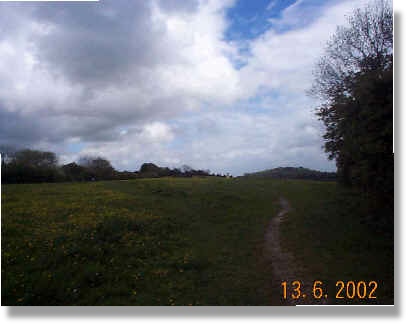
Pewley Down and The Pilgrims Way
Threatened by Artificial Tree!
Right on our doorstep is one of the most beautiful, historic and mysterious stretches of landscape in South East England. If you stand at the Pewley Hill entrance to Pewley Down and look south it seems you’re looking at a broad, green road. That is exactly what it is. Centuries before the Romans arrived this was part of a major prehistoric trackway. It ran from the Kentish coast along the top of the chalk escarpment of the South Downs. At Farnham it bifurcated: one branch went south to what would be Winchester, the capital of England the other went to (wait for it) Stonehenge.
In the 19th Century it was called the Pilgrims’ Way and is marked as such on the older Ordnance Survey maps. However, it was so obviously silly that people like Chaucer’s pilgrims would travel 30 miles south-west in order to turn east to Canterbury that the name was dropped and it is now known, prosaically as the North Down’s Trackway.
I walked the section from Guildford to Canterbury some years ago. About a third of the length is now a metalled highway, modern road engineers and prehistoric travellers sharing the same idea as to what made a good road. Parts of it - even - sections with London postal district names – remain astonishingly unchanged, If you want to see what a “road” in England was like before the 18th century, walk along the trackway in the valley just inside the Chantries. This is part of the Pilgrims’ Way complex’ Why are there two such major trackways just half a mile from each other? There are many romantic theories to account for it. The simple and practical reason is that, in summer, the high footpath on chalk is compacted as hard as concrete while the sandy footpath lower down is dry and difficult to walk through. In winter it’s just the opposite. The upper trackway path is sticky while the sand of the lower trackway is damp and firm.
here is another “road” on Pewley Down – which happily was strangled at birth. It looks like a continuation of Fort Road - and that is exactly what it was meant to be. In 1911 the Austen Estate, the owner of Pewley Down decided to build over it and the continuation of Fort Road was the first step. It caused a tremendous local outcry, an outcry taken up by the mighty London Times itself who published the famous squib:
A sin it is in man or woman
To steal the goose from off the common
But that man’s morals must be loose
Who steals the common from the goose
The project was dropped. After World War I the local Friary Brewery very generously bought the Down and presented it to the town as a war memorial. It is also now part of the Green Belt and, in that hideous official jargon, is also An area Of Outstanding Natural Beauty. So it should be safe.
But is it? There is a planning application before the Borough Council to erect a 20 metre telephone mast on the edge of the down. Worse still. Below the mast will be brick “cabins” behind a protective fence - a miniature industrial site in this sensitive area. Worst of all – an access road is planned running parallel to the footpath which connects the Down to Warren Road. Apart from the hideous effect of such a scar on that beautiful hillside it will establish a precedent for building on that agricultural land. Final absurdity: the mast will be the form of an artificial tree. A fake Christmas tree 60 feet high visible for miles around!
Objections should be sent to Guildford Borough Council quoting: 02/P/00713.

Stand by to repel boarders!
Russell Chamberlin

